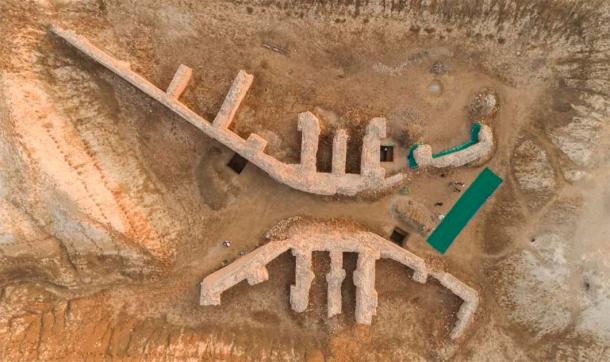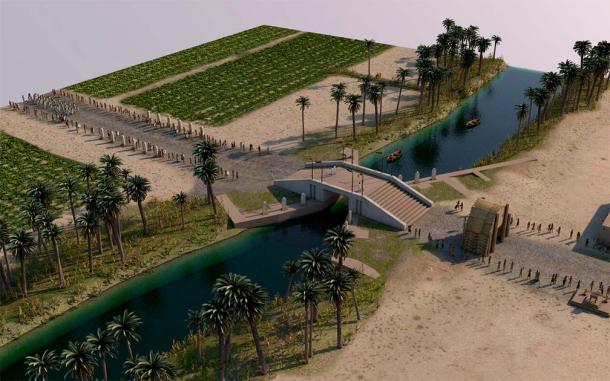
Sumerian Anti-Armageddon Device 4,000 Years Older Than Believed
Drone mappers identified a 19 kilometer (12-mile) long canal in rural Iraq. Built over it, archaeologists excavated what was at first thought to be a bizarre-shaped temple. However, it turns out that ,4,000-years-ago, ancient Sumerians built “a one-of-a-kind anti-drought machine.”
Located near the modern city of Nasiriyah, in southern Iraq, the ancient city of Girsu was occupied by the Sumerian civilization from the 3rd millennium BC. Dedicated to the war and agriculture god Ningirsu, artifacts recovered from the site have illustrated both the religious and political history of early Mesopotamian society.
A recent dig by the British Museum at Girsu revealed “a mysterious structure,” which in the 1920s was interpreted as an unusually shaped temple. However, members of the museum’s Girsu Project have now announced that the curious discovery was a 4,000-year-old “innovative civilization-saving machine.”

Aerial view of the structure in the ancient city of Girsu (modern Tello). (British Museum)
A One-Of-A-Kind “Anti-Drought Machine”
The British Museum describe the ancient lifesaving device as a “flume” that was used to deliver water to distant locations for agriculture. Ebru Torun, an architect and conservationist working with the British Museum archeologists in Iraq, said “no other example of it exists in history, really, until the present day. It’s absolutely one-of-a-kind.”
- 4,500-Year-Old Sumerian Palace Uncovered in Iraqi Desert
- Ritual Site Dedicated to Mesopotamian War God Discovered in Iraq
Torun said that what is most surprising about the find is that until now archaeologists thought such technologies didn’t appear until the 18 th century AD! However, the ancient Sumerians had invented “an anti-drought machine,” in what was a desperate attempt to save their canals from drying up, to avoid agricultural Armageddon.
The Unique Device Is Also An “Anti-Collapse Bridge”
Ancient Sumer is associated with the emergence of the world’s first civilization and writing. As the civilization expanded, increasing populations depended on more water for sustained survival. This was achieved by redirecting water from the Tigris and Euphrates rivers into canals, which fed wells and reservoirs in population centers.
In a Telegraph article, Dr. Sébastien Rey, an archaeologist and the project’s leader in Iraq, explained that the people “saw the canals drying up, silting up, one by one.” He added that “It is not just a bridge, it’s an anti-drought machine, anti-collapse.” Furthermore, all of the inscribed stone tablets speak of “a water crisis, and one last desperate attempt to save themselves,” added Rey.

A digital reconstruction of the flume, which once straddled a 12-mile canal. (The Girsu Project/British Museum)
The Day The Gods Got Up And Left
Ancient Sumerian writings describe complex sacrifice and libation rituals made in honor of fertility and water gods. Sacrifices involved offering animals to seek divine assistance, while libations included pouring liquids like water or beer as symbolic gestures of nourishment. These rituals, integral to daily temple routines and major festivals, aimed to maintain the favor of the gods and establish a harmonious connection between the Sumerians and their deities.
Sometime around 2000 BC, however, the gods stopped responding to the Sumerians’ traditional rituals. Seeing their canals and wells drying up, the people of Girsu were inspired into inventing, designing, and then building two symmetrical mud-brick structures. Measuring 40 meters (130 feet) long, 10 meters (33 feet) wide, and 3.3 meters (11 feet) tall walls, the structures feature two opposing outward facing curved channels.
Excavating The World’s Oldest Bridge
The team of scientists have been flying drones around the village of Nasr, on the British Museum’s Girsu Project, and they determined that the “life-saving machine” was positioned upon a 19 kilometer (12-mile) long canal. And because the device spans a waterway it’s being called “the world’s oldest known bridge.” Until now, the title of the world's oldest bridge is most often associated with the Jisr al-Hajar Hajirah, or Caravan Bridge, in the ancient city of Edessa, or present-day Urfa, in Turkey, which dates back to around 850 BC.
- Looted Iraqi Antiquities Can Finally Return Home After Simple Identification by British Museum
- The Mythical Dilmun and The Island of the Dead
The life-saving structure channeled the long canal into a 5-meter (13-foot) wide passage, creating what the researchers refer to as the “Venturi” effect, which wasn’t formally described by scientists until the late 18th century. The Girsu flume was built by the last people living in Girsu, who attempted to push water to distant downstream farming regions, including the administrative capital of Lagash, in a last-ditch attempt to avoid agricultural armageddon.
Changing climate in the second millennium BC altered the traditional courses of Mesopotamian rivers around which communities flourished. However, in the face of being abandoned by the gods, Sumerian ingenuity increased, and this discovery represents the birth of a new generation of hydraulic technologies.
Top Image: The British Museum’s ongoing Girsu Project discovered the true function of a mysterious structure. Source: British Museum/Dr. Sébastien Rey
By Ashley Cowie
















Comments
"The Day The Gods Got Up And Left" should read 'The Day That God Abandoned Sumer'.
Sumer was, no doubt, a den of iniquity. Just like today, we can marvel at the technology and forget the immorality, injustice and impiety, because it suits us to do so.
However, God had other plans. He usually does.